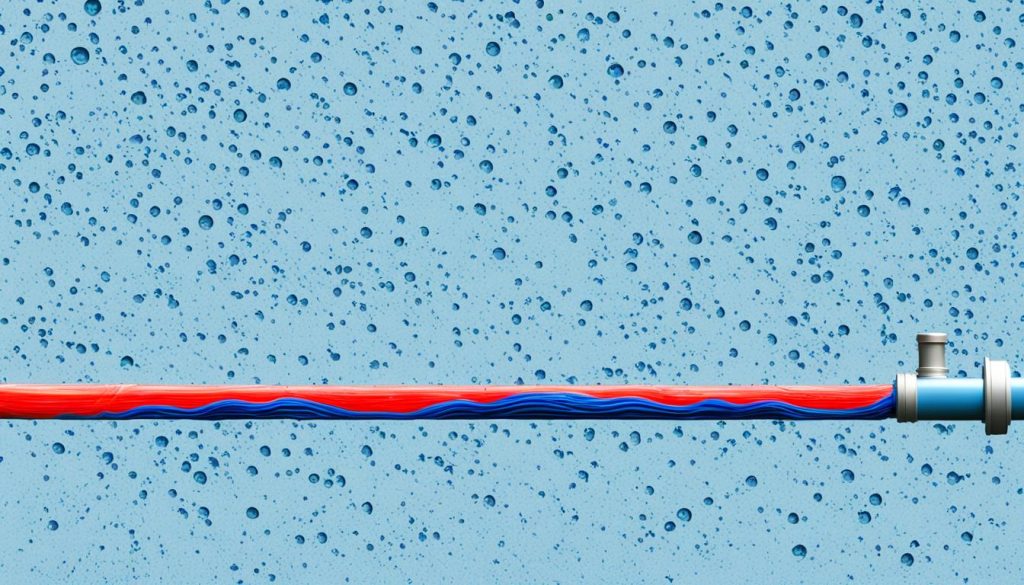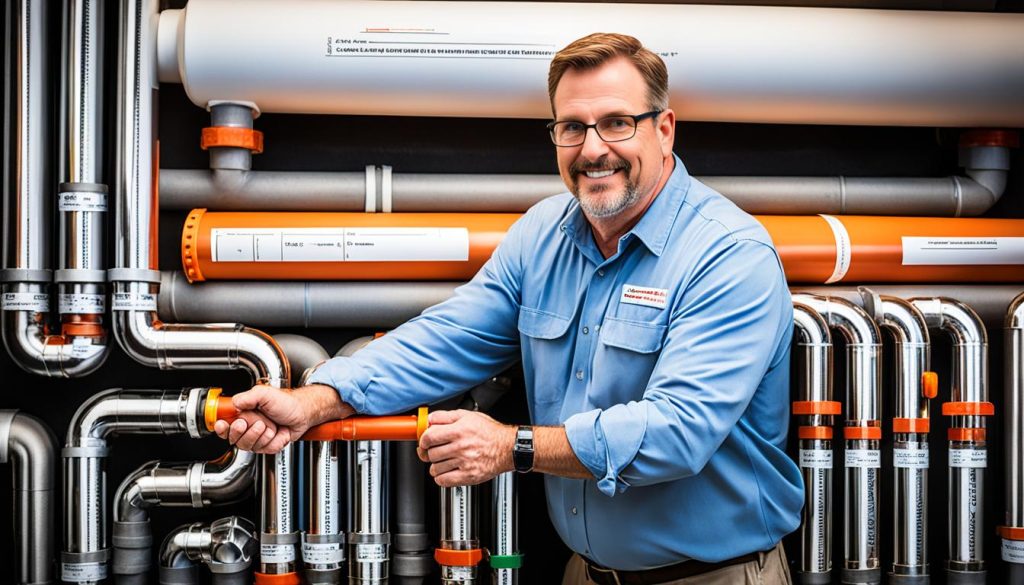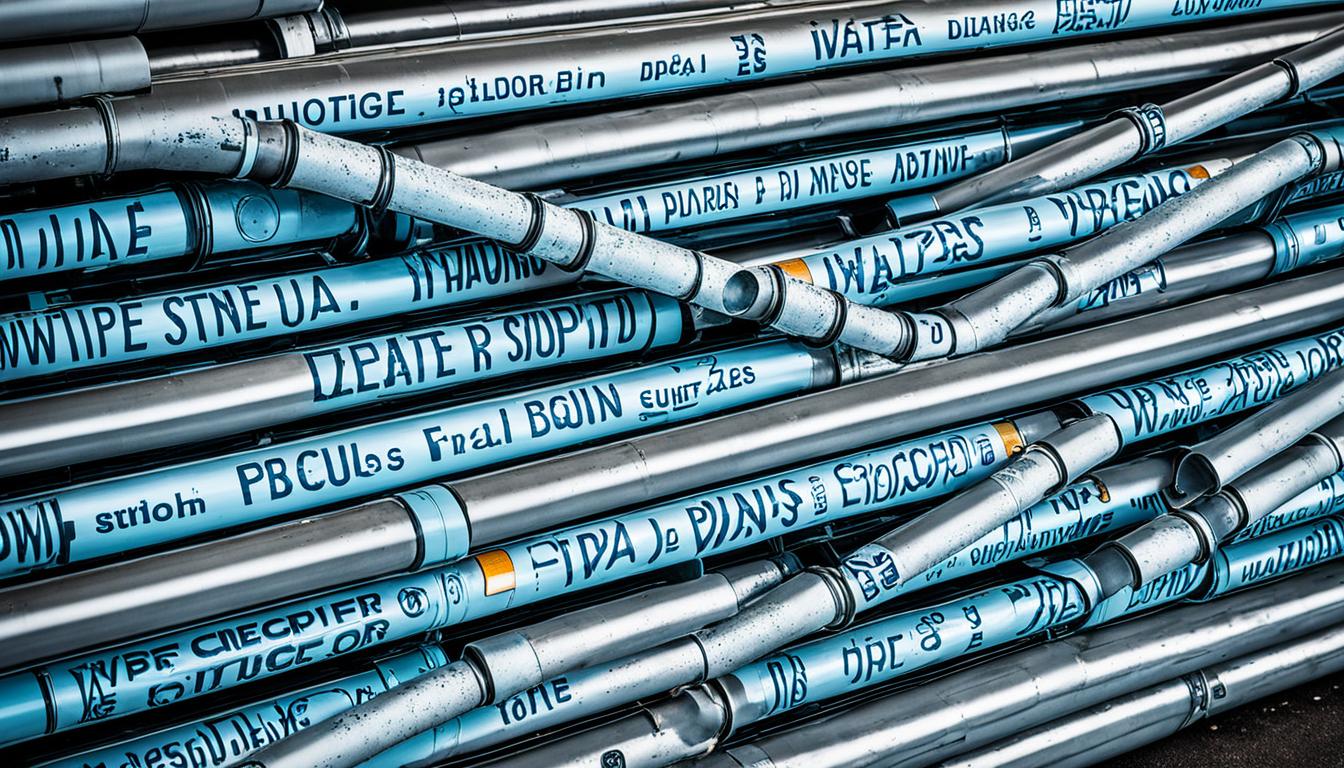Did you know that selecting the wrong pipe size for your plumbing system can lead to reduced pipe lifespan, noise, and pressure drop? It’s crucial to understand the importance of choosing the right water pipe sizes to ensure optimal performance and efficiency.
Key Takeaways:
- Understanding nominal pipe size is essential when selecting fittings based on pipe dimensions.
- Pipe and tubing can be sized based on the outer diameter (OD) or the inner diameter (ID), depending on the fitting size.
- Proper pipe sizing is crucial for efficient plumbing systems, considering factors such as maximum and minimum velocity and pressure drop.
- It’s important to design pipe systems with the most direct routing to minimize pressure drop and optimize water flow.
- In some cases, the decision between adding a pump or adjusting pipe sizes must be carefully evaluated based on project requirements.
The Importance of Proper Pipe Sizing
Proper pipe sizing plays a vital role in ensuring the efficiency of plumbing systems. When it comes to choosing the right pipe size, there is no one-size-fits-all solution. Using an incorrect pipe size can lead to various issues, including non-compliance with pipe sizes, reduced pipe lifespan, excessive noise, and significant pressure drop.
To avoid these problems, it’s crucial to understand the importance of selecting the correct pipe size. If the pipe is too small, the water velocity will be too high, causing turbulence and pressure issues. On the other hand, if the pipe is too big, the water velocity will be too low, preventing the self-cleansing velocity required to prevent biofilm growth and maintain water quality.
When determining the appropriate pipe size, several factors need to be taken into consideration. These include the maximum and minimum velocity limits and the pressure drop per meter. By designing the system based on these parameters, optimal pipe sizing can be achieved, ensuring that the plumbing system meets the specific requirements of the application.
The Importance of Maximum and Minimum Velocity
Maximum velocity is an essential parameter to consider when sizing pipes. It helps prevent water from flowing too quickly through the pipes, which can lead to issues such as pipe erosion and increased noise levels. The maximum velocity limit depends on various factors such as the pipe material, fluid type, and building location. For example, cold water pipes typically have a maximum velocity limit of 1.5-2.4m/s (5-8ft/s), while hot water pipes have lower limits.
Minimum velocity is equally important to maintain the self-cleansing velocity required to prevent the accumulation of biofilm. Biofilm can lead to water quality issues and pipe blockages. A minimum velocity of 0.6m/s (2ft/s) is generally recommended to ensure adequate cleansing of the pipes.
Overall, selecting the correct pipe size is crucial for the optimal performance of plumbing systems. By considering factors such as maximum and minimum velocity, as well as pressure drop, designers and engineers can ensure that the pipes meet the specific requirements of the application. The next section will focus on determining the maximum and minimum velocity for pipe sizing.
Determining Maximum and Minimum Velocity
When it comes to water flow through pipes, it’s crucial to consider the maximum and minimum velocity limits to ensure optimal performance. The maximum velocity limit prevents water from flowing too fast, while the minimum velocity limit maintains self-cleansing velocity to prevent biofilm buildup.
Maximum Velocity Limit
The maximum velocity limit for pipes depends on various factors, including the location of the building, pipe location, pipe material, and type of fluid. Cold water pipes typically have a maximum velocity limit of 1.5-2.4m/s (5-8ft/s). On the other hand, hot water flow and return pipes have lower maximum velocity limits of 1.2m/s (4ft/s) and 1m/s (3ft/s) respectively.
Minimum Velocity Limit
The minimum velocity limit is just as important as the maximum velocity limit. It ensures adequate water quality by maintaining self-cleansing velocity and preventing the buildup of biofilm. A minimum velocity of 0.6m/s (2ft/s) is generally recommended to achieve this goal.
By understanding and adhering to these maximum and minimum velocity limits, you can ensure optimal water flow and prevent any potential issues related to water quality and system efficiency.

Maximum and Minimum Velocity Limits
| Pipe Type | Maximum Velocity Limit | Minimum Velocity Limit |
|---|---|---|
| Cold Water Pipes | 1.5-2.4m/s (5-8ft/s) | 0.6m/s (2ft/s) |
| Hot Water Flow Pipes | 1.2m/s (4ft/s) | 0.6m/s (2ft/s) |
| Hot Water Return Pipes | 1m/s (3ft/s) | 0.6m/s (2ft/s) |
Managing Pressure Drop
When it comes to sizing pipes, considering pressure drop is crucial. Excessive pressure drop throughout the system can lead to the need for additional pumps, resulting in increased costs, higher energy consumption, and more maintenance. To manage pressure drop effectively, one approach is to size the pipes based on the maximum pressure drop that can be tolerated. By calculating the pressure drop through the pipes and selecting appropriate pipe sizes, it’s possible to minimize pressure drop and avoid the need for additional pumps.
Pressure drop occurs when there is a decrease in pressure from one point in the pipe system to another. This drop can happen due to factors such as friction, changes in elevation, or restrictions in the pipe. Understanding and managing pressure drop is essential to ensure optimal performance and efficiency of the plumbing system.
Calculating pressure drop involves considering various factors, including pipe length, diameter, flow rate, and fluid properties. By using pressure drop calculation formulas specific to the pipe material and system configuration, engineers can determine the expected pressure drop and select appropriate pipe sizes to minimize its impact.
Here is an example of a pressure drop calculation formula for a straight pipe:
Pressure Drop Calculation Formula (Straight Pipe)
ΔP = 0.5 * ρ * V^2 * L / D
Where:
- ΔP is the pressure drop (in units of pressure, such as Pa)
- ρ is the fluid density (in units of mass per volume, such as kg/m³)
- V is the fluid velocity (in units of length per time, such as m/s)
- L is the pipe length (in units of length, such as meters)
- D is the pipe diameter (in units of length, such as meters)
By utilizing the pressure drop calculation formula and considering the specific requirements of the system, engineers can ensure that pipe sizes are selected to minimize pressure drop and optimize the performance of the plumbing system.
Pipe Sizing Example
To understand the pipe sizing process, let’s explore a simple project as an example. In this case, we’ll focus on designing a pipe system that meets the specific requirements of the application. To achieve optimal performance, we need to consider several factors and follow a systematic approach.
Project Overview
- Water main pressure: 80 psi
- Flow rate: 12 GPM
- Fixture height: 10 feet
- Valve and fitting pressure loss: 4 psi
I will now calculate the pipe sizes using the appropriate formulas and calculations. This will ensure that the designed system performs efficiently and adequately handles the flow requirements.
| Component | Length (ft) | Diameter (inches) | Pressure Loss (psi) |
|---|---|---|---|
| Main Branch | 50 | 2 | 2 |
| Branch 1 | 30 | 1.5 | 1.5 |
| Branch 2 | 40 | 1 | 1 |
| Branch 3 | 25 | 0.75 | 0.75 |
By calculating the pressure loss through each component, we can determine the appropriate pipe sizes required for the project. Here’s a simple illustration:

In this example, the main branch requires a 2-inch diameter pipe to accommodate the flow rate while minimizing pressure loss. Each subsequent branch is sized accordingly to maintain adequate flow and pressure.
By considering the factors mentioned and following a systematic approach, engineers can effectively design pipe systems that meet the specific requirements of similar projects. The example showcases how pipe sizing calculations ensure optimal performance and efficient water flow throughout the system.
Pipe Layout and Direct Routing
When designing pipe systems, it’s crucial to consider the layout and routing of the pipes. By taking the most direct route, we can minimize the number of bends and pipe length required, resulting in efficient water flow and reduced pressure drop. An optimized pipe layout allows us to maximize the performance of the plumbing system while minimizing the need for additional pumps or modifications.
Direct routing is essential to ensure smooth water flow through the pipes. By avoiding unnecessary detours and bends, we can minimize friction and turbulence, which can lead to increased pressure drop and reduced system efficiency. A well-thought-out pipe layout helps to maintain optimal water pressure and ensures that all fixtures and endpoints receive adequate flow and pressure.
- Water source: Located at the center of the building for equal distribution.
- Main supply line: Directly routed from the water source to the furthest endpoints. This minimizes pressure drop and ensures sufficient pressure at all fixtures.
- Secondary branches: Connected to the main supply line at regular intervals to supply water to different areas of the building.
- Fixtures: Positioned along the secondary branches in a logical order to optimize water flow and minimize pipe length.
By following these principles of pipe layout and direct routing, engineers can create efficient plumbing systems with optimal water flow and minimal pressure drop. This not only improves the performance and longevity of the system but also reduces energy consumption and maintenance costs.
Choosing Between Pump or Pipe Sizing
In certain situations, engineers may face a decision between adding a pump or adjusting pipe sizes to meet the required design parameters. Each option presents its own set of advantages and disadvantages, and it is essential to consider project-specific factors when making this choice.
Adding a pump can offer the necessary pressure to meet minimum requirements, but it does come with additional costs, energy consumption, and maintenance requirements. On the other hand, adjusting pipe sizes to minimize pressure drop can eliminate the need for a pump, but it may necessitate the use of larger pipes, resulting in higher material costs.
When faced with the pump sizing or pipe sizing dilemma, engineers need to evaluate the trade-offs based on factors such as budget, energy efficiency, maintenance resources, and project constraints.
By carefully weighing these considerations, engineers can choose the option that best aligns with the specific needs and priorities of the project. This decision-making process ensures that the selected approach optimizes performance, minimizes costs, and maximizes efficiency.
Pros and Cons of Pump Sizing
- Advantages:
- Provides necessary pressure to meet minimum requirements
- Can overcome limitations associated with pipe sizes
- Allows for flexibility in system design and layout
- Disadvantages:
- Increases upfront costs due to the purchase and installation of a pump
- Consumes additional energy, leading to higher operational costs
- Requires regular maintenance to ensure optimal performance
Pros and Cons of Pipe Sizing
- Advantages:
- Avoids the need for a pump, reducing upfront and operational costs
- Minimizes energy consumption, resulting in improved energy efficiency
- Simplifies the system by relying on pipe dimensions rather than pump mechanics
- Disadvantages:
- May require larger pipe sizes, leading to increased material costs
- Can pose challenges in retrofitting existing systems with limited space availability
- Places more emphasis on accurate pipe sizing calculations
Conclusion
Proper water pipe sizing is crucial for efficient plumbing systems. By taking into account factors such as maximum and minimum velocity and pressure drop, engineers can design pipe systems that meet the specific requirements of each project. This ensures optimal water flow, minimal pressure drop, and overall system performance.
Direct routing of pipes and careful consideration of layout further enhance system efficiency. By taking the most direct route and minimizing the number of bends and pipe lengths, engineers can optimize water flow and reduce pressure drop. This not only improves the performance of the plumbing system but also minimizes the need for additional pumps or costly modifications.
In situations where pressure requirements cannot be met solely through pipe sizing, the decision between adding a pump or adjusting pipe sizes should be carefully evaluated. Each option has its own advantages and disadvantages, and the choice should be based on project-specific considerations such as cost, energy consumption, and maintenance requirements.
In conclusion, following best practices for water pipe sizing is fundamental in designing plumbing systems that operate efficiently. By considering various parameters, optimizing pipe layout, and making informed decisions, engineers can ensure proper water flow, minimal pressure drop, and optimal performance for plumbing systems.
Source Links
- https://www.freshwatersystems.com/blogs/blog/pipe-dimensions-and-nominal-pipe-size
- https://www.h2xengineering.com/blogs/how-to-size-water-pipes/
- https://www.pdhonline.com/courses/m270/m270content.pdf
